|
|
|
|
BackgroundWindsor has been without
a direct road link to Eton since April 1970, when engineers decided
that the old cast iron bridge was no longer up to the task of
carrying thousands of vehicles, including buses, day in day out,
as cracks had developed in the supporting cast iron girders. In this
article we look at the history of Windsor Bridge. The Early History of Windsor BridgeThe story of Windsor Bridge
starts almost 1000 years ago, when William the First, William
the Conqueror, first established a fortification on the chalk
ridge known as Clewer Hill, and which subsequently became the
castle we know today. This history of the Castle and the town
is covered in other articles on the Windsor Web Site, (A
Brief History)
for now it can be imagined that the movement of the court, from
Old Windsor, at Kingsbury, to 'New' Windsor surrounding the castle,
would have almost immediately required a wharf and a crossing
of some sort to the northern bank, subsequently to become Eton.
No doubt ferrymen would have filled the demand for a good few
years, but it is likely that the first wooden bridge was built
in the 1100s. It is recorded that in 1172 a certain Osbert de
Bray a farmer from Windsor, derived £4 33p from tolls levied
on vessels passing beneath the bridge. This must have been lucrative
for de Bray as river travel was very popular form of transport
when the road system hardly existed. Alfred the Great apparently
travelled from Oxford to London by river in 875. Two hundred
years later the Doomsday Book records that goods were sent by
river since Edward the Confessor's time (1050). River cargoes
to the court at Old Windsor included wine, iron, ropes, royal
baggage, even prisoners. Ships could be 'free from molestation'
by royal gift. The river was therefore an important highway from
London, Hampton Court, Richmond and Staines, through to Windsor,
and onward as far as Oxford and the Midlands. The Decision to Build The Bridge We Know TodaySome 60 years earlier, at Ironbridge, a new material had been discovered that offered much more strength and durability than wood. This material was cast iron. As a testament to this durability, the structure at Ironbridge still stands to this day. It remains the very first metal bridge anywhere in the world. 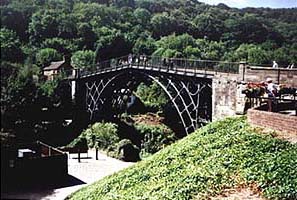 Design and Construction 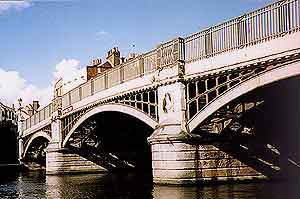 The bridge was built by
Mr William Moore (who died before its completion) and completed
by Moore's executor, Mr Baldock. During construction a barge
hit the works and sank, the cast iron ribs from Wales included
some that were defective and broke as they were unloaded, replacements
having to be made in London, while others were 'repaired'. A
labourer working on the 'piling' slipped and fell as the "monkey"
(hammer) was on its downward path. He was crushed to death leaving
a wife and "a number of children". Express, May
25th 1822. 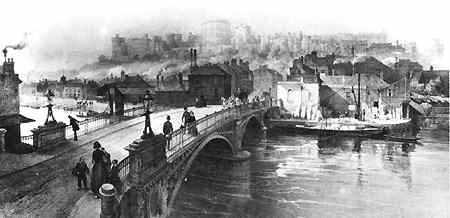 Click here for more pictures of Windsor Bridge in the 1800s The bridge was constructed as three arches supported by two massive granite pillars set deep into the river bed. Between each pillar were seven supporting arches in cast iron. It was not until 1830 that a critic of cast iron, Mr Eaton Hodgkinson, proved that cast iron was only one sixth as strong in tension as in compression, to the horror of Windsor Corporation with their newly completed cast iron bridge over the Thames. They thought that every precaution had been taken, even the great Thomas Telford had been consulted, although this was mainly about the foundations. We now know of course that the Corporation need not have worried because Windsor Bridge is an arch bridge, and therefore the cast iron is in compression mostly and perfectly adequate for its purpose, as the subsequent 150 years proved. It is true that the bridge developed cracks at some point in its history, (in those areas where the was an element of tension), but it had already been used for a very long time by heavy traffic that the original designer could not possibly have envisaged. The New Windsor Coat
of Arms 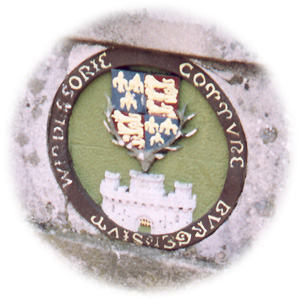 Featuring the Royal Standard of Edward I and the castle motif of his Queen, Eleanor of Castile. Edward I granted New Windsor its first Borough Charter on 28th May 1277
Windsor Town Bridge is Completed in 1824In an entry in the Express,
dated May 1st 1824, a relieved editor could publish that
''We have the greatest satisfaction in stating that the Windsor
Bridge is built at last. The highly respectable engineer, Mr
Charles Hollis, has pledged himself to the structure, the completion
of which has been long delayed and will be ready to open this
year." 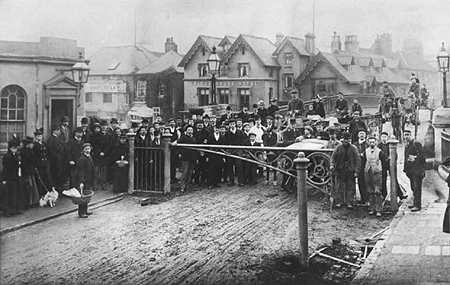 A Year Book,
wrapped in a Macintosh bag, was found under the Foundation Stone
of the Destructor in Dedworth containing some details about Windsor
Bridge. The Destructor (for rubbish disposal) had been built
in 1904 and was destroyed by a flying bomb on July 1st 1944.  In August, 1938, Col. Barker, then Chairman
of the County Highways Committee, said that "the bridge
was a bad type, it was cracked in three places and was really
unsafe. " The rebuilding of the bridge was certain to come
within the next few years."
Cracks Force Restrictions in 1969 and Closure in 1970After 150 years the original pessimism of Mr Hodgkinson in 1830 proved right, when, in 1969 at an Emergency Meeting of the Surveyor's Department of Berkshire County Council, who had responsibility for major roads by that time, it was decided that cracks in the cast iron arches required traffic to be restricted to a single line controlled by lights. By April 10th 1970 the last vehicle crossed the bridge at 4.00pm following another Emergency Meeting in the Borough Engineer's office in Windsor, in the presence of county officials and the police. Posters, diversion signs, re-routing of buses and press publicity all marked the demise of the bridge as a main vehicle route across the Thames at this point. 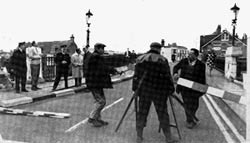 Immediately pressure from
local traders built up for a temporary bridge of some kind, especially
those on the Eton side. Eton Urban District Council was particularly
anxious to see the bridge reinstated in some form or other. In
1963 the damaged Victoria Bridge had seen a war-time Bailey Bridge
erected over it to maintain the Windsor - Datchet link, and demands
were voiced immediately for a similar structure to be installed
over Windsor Bridge but the Borough Engineer at the time, Gordon
Cullingham, produced a report and montage showing how such a
bridge would seriously affect the area. In March 2000 the Borough undertook a load assessment on the bridge and decided that there was 'insufficient capacity to carry unmanaged pedestrian loading'. For this reason restrictions were set up on the bridge using temporary barriers that prevented pedestrians from walking on the central areas of the bridge. 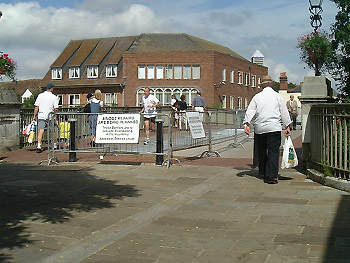 The report found that whilst
the main arch ribs were generally good, 40% of the spandrels
were cracked or sheared. The Metalock repair method was proposed,
which is virtually invisible. At the same time parapet strengthening
was thought advisable due to the high levels of pedestrian use.
Plans were drawn up featuring a second parapet adjacent to the
first, with integral lighting. York stone would be used for the
paved area instead of the paving slabs and concrete blocks previously
used and which would match other local schemes. 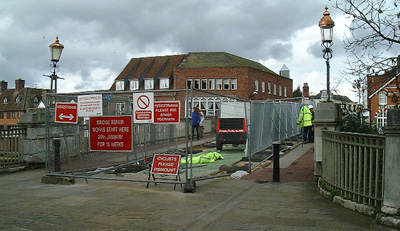
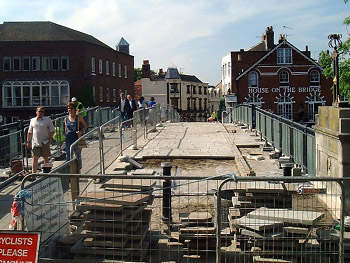 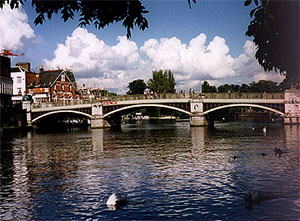 Photographs by George Washington Wilson |
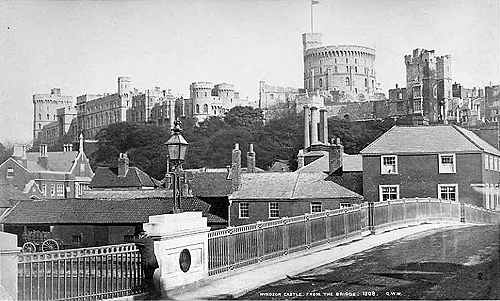
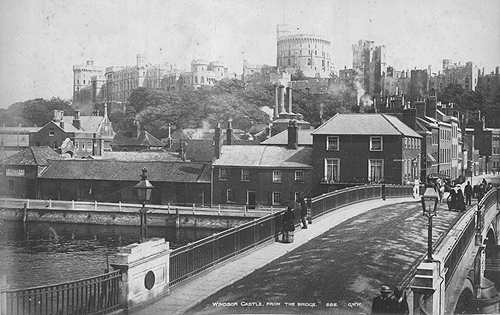
|
Elizabeth Bridge takes the strainWindsor is fortunate that the Elizabeth Bridge and the Relief Road, by-passing the town centre and Eton High Street, had been completed in 1966, five years before the town bridge had eventually to be closed, as this could accept diverted traffic without difficulty, though not without inconvenience to local shoppers, and the concerns of traders in Eton. The bridge was opened on 11th July 1966. Had the Elizabeth Bridge not been completed, traffic diversions would have been major, requiring traffic for many miles around the town being directed further up the Thames to Maidenhead and the M4 crossing, or funnelling large volumes of traffic through Datchet village via the Victoria Bridge. 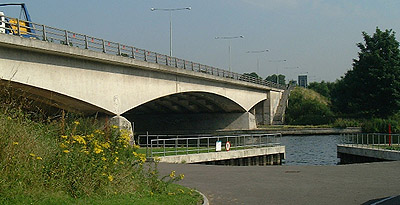 The bridge connects routes from the south of the Thames with the M4 at Slough References and Further Reading
Dredge's Bridges of the Thames. Windsor Bridge 1851 Tighe folio re Albert and Victoria Bridges (Windsor Library) Parish Magazine (Trinity Church) features a story about a young boy being taken by his father to view the construction of Victoria Bridge. (Copy not located at time of writing) Berkshire Records, previously at Shire Hall, Shinfield Park, Reading, Berkshire received the 'Bridge Box' from Windsor, however, records and archives, scattered since the demise of Berkshire County Council, have not been indexed as of 2000. Daphne Phillips, How the Great Western came to Berkshire. Page 28. Reading Library, 1975. ISBN 0 9501338 5 X
To contact us, email Thamesweb.
|